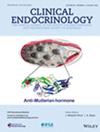Osteocalcin in Infancy and Early Childhood and Its Correlation With Later Growth and Body Composition: A Longitudinal Birth Cohort Study
Abstract
Background
Osteocalcin is a metabolic active hormone, which correlates positively with bone formation and inversely with body mass index and waist circumference in adults.
Objectives
To investigate whether osteocalcin in infancy and early childhood were related to childhood growth or body composition.
Methods
A Swedish longitudinal birth cohort with blood samples from 551 children from birth until 5 years of age. Regular anthropometric measurements were carried out up to 8 years of age and dual-energy X-ray absorptiometry (DXA) scans were also performed at 8 years. The results included p-values and Spearman's rho (ρ).
Results
Osteocalcin at 4 months of age correlated inversely and consecutively with weight from 4 to 24 months and to waist circumference from 6 to 24 months in boys. The correlations for girls were limited to weight at 4 months and waist circumference at 6 and 18 months (ρ < 0.3, p = 0.001 to 0.048). The boys' osteocalcin levels at 5 years correlated positively with their height and weight at 5 and 6.5 years (ρ < 0.3, p < 0.01). Meanwhile, the girls' osteocalcin at 3 years showed positive correlations to all weight and height measurements until 8 years of age (ρ < 0.3, p = 0.003 to 0.023). DXA data showed that the boys' osteocalcin at 5 years correlated with the fat-free mass index (FFMI) (ρ 0.212, p = 0.026) but not the fat mass index (FMI) at 8 years. The opposite was seen for the girls' osteocalcin at 3 years, which correlated with FMI (ρ 0.222, p = 0.020) but not FFMI.
Conclusion
Early levels of osteocalcin showed inverse correlations with later weight, height and body composition in infancy and positive correlations during childhood. The weak but consistent correlations suggest that osteocalcin carries information about future growth. Girls with high osteocalcin at 3 and 5 years had a larger fat mass at 8 years, while boys, in contrast, had a larger lean mass. These sex differences need to be further explored.

 求助内容:
求助内容: 应助结果提醒方式:
应助结果提醒方式:


